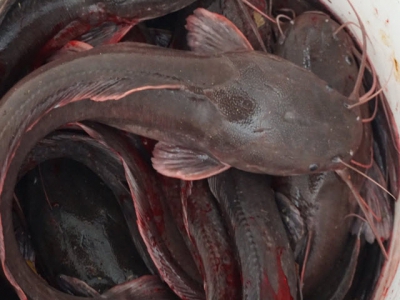Improving hatchery performance in Catfish Country

Plans to step up catfish production in the Philippines have been given a boost, after water quality issues were identified at one of the country’s key hatcheries.
African catfish (Clarias gariepinus) broodstock in Zarraga, awaiting the removal of eggs for external fertilisation. Photo: JR Pagador
Zarraga, in Iloilo, is known by some as “Catfish Country”, but farmers such as Zarraga Pantat Fingerlings have struggled to keep pace with buyers’ demands due to issues with low hatch rates and juvenile mortalities.
Larry Pañoso, who is in charge of hatchery operations at Zarraga Pantat, said that they achieved a breakthrough in January when their production reached an all-time high of 500,000 fry per week after the Southeast Asian Fisheries Development Center Aquaculture Department (SEAFDEC/AQD) helped resolve a problem with the hatchery's water source.
In early 2020, the hatchery produced just 60,000 fry per week, and production began to decline further in June 2020 when eggs failed to hatch.
“We had no idea why this was happening,” Pañoso told SEAFDEC. “We were wondering why this suddenly happened after a few months of stable production.”
Dan Baliao, SEAFDEC/AQD chief, reported that the facility’s water was too hard for the catfish eggs and affected their hatching. This was after the centre dispatched a chemist, a fish biologist, microbiologists and engineers to holistically evaluate the hatchery operations.
One of the deep wells that served as the farm’s primary water source reached hardness levels as high as 500 parts per million (ppm), while water hardness levels for egg hatching should ideally be between 30 and 60 ppm.
Hardness refers to the amount of calcium carbonate present in the water - purified water is considered soft, with less than 50 ppm, while hard water is above 170 ppm and is typical of ground water.
Upon advice by Dr Rolando Pakingking Jr, a scientist at SEAFDEC/AQD, Pañoso mixed rainwater, a soft water source, with the water from the deep well supply used in the hatchery to reduce the water hardness level in the hatching tanks.
“Since then, we didn’t encounter any further problems and are continuously producing fry for our clients,” said Pañoso, who reported producing 500,000 fry per week during the second and third weeks of January 2021.
Pañoso also told SEAFDEC/AQD that they are upgrading biosecurity in the hatchery by disinfecting broodstock and eggs after each induced spawning session. They also have become more vigilant in monitoring water parameters.
“Water parameters like pH, salinity, and hardness matter to the rearing of freshwater species, so constant monitoring is an integral component of good aquaculture practices,” emphasized Pakingking.
Baliao said that, with the mounting demand for technical assistance from the aquaculture industry, the research centre is working to make its experts more available to help fish farmers.
“We have made it our policy to encourage direct involvement of our experts, as long as they are available, to hasten the commercialisation of research results,” he added.
Related news
Tools

Phối trộn thức ăn chăn nuôi

Pha dung dịch thủy canh

Định mức cho tôm ăn

Phối trộn phân bón NPK

Xác định tỷ lệ tôm sống

Chuyển đổi đơn vị phân bón

Xác định công suất sục khí

Chuyển đổi đơn vị tôm

Tính diện tích nhà kính

Tính thể tích ao



 Novel feed ramps up tilapia farmers' profits
Novel feed ramps up tilapia farmers' profits  Bến Tre’s shrimp sector targets production value of…
Bến Tre’s shrimp sector targets production value of…